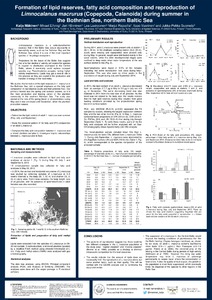Formation of lipid reserves, fatty acid composition and reproduction of Limnocalanus macrurus (Copepoda, Calanoida) during summer in the Bothnian Sea, northern Baltic Sea
Rajasilta Marjut; Vuorinen Ilppo; Elfving Mikael; Laaksonen Lea; Mäkinen Katja; Hänninen Jari; Suomela Jukka-Pekka
https://urn.fi/URN:NBN:fi-fe2021042718003
Tiivistelmä
Limnocalanus macrurus is a cold-stenothermic copepod that in the Baltic Sea occurs abundantly in low-salinity areas, such as the Bothnian Bay and the Bothnian Sea, where it is one of the most important species of the pelagic ecosystem. Projections for the future of the Baltic Sea suggest that a further decline of salinity will enable the species to expand its distribution southward to the Central Baltic, where it eventually could replace copepod species, e.g. Pseudocalanus acuspes, having higher salinity requirements. Lipids may get a central role in this process as they are crucial in the production and transfer of energy in the food webs. We studied the formation of the lipid reserves in L. macrurus in the Bothnian Sea, with a special emphasis on the fatty acid composition in reproductive adults and their potential food. Our primary interest was the spring and summer season, as it is the main production and feeding period of the plankton community in the southern Bothnian Sea. The study was started at the time of the spring bloom of phytoplankton during May and it was continued until September, when the plankton production ceases.
Kokoelmat
- Rinnakkaistallenteet [19218]
